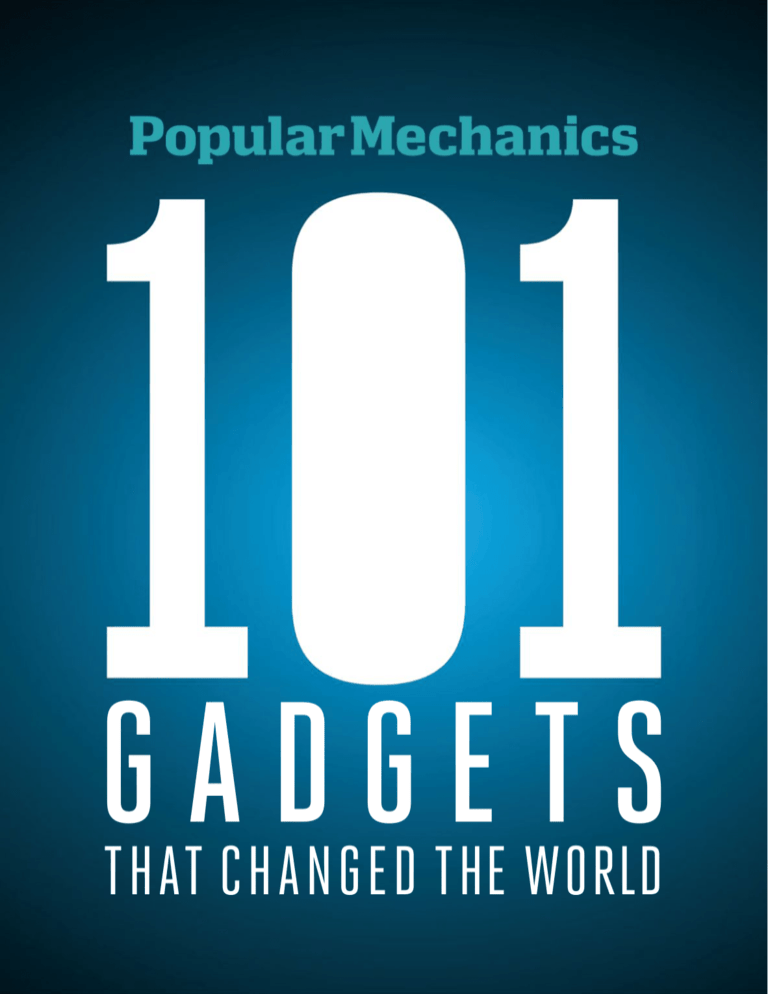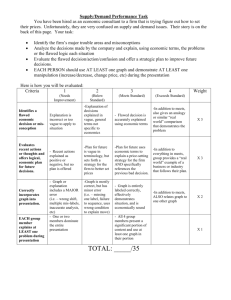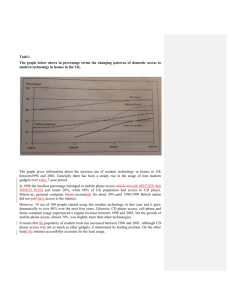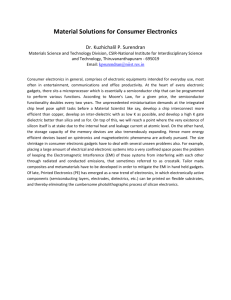Popular Mechanics 101 Gadgets 2013
advertisement

GTHATACHANGED D G THEE WORLD TS 1897: WESTERN ELECTRIC TYPE 21 (WALL-MOUNTED ERA, 1890 TO 1905) 1937: WESTERN ELECTRIC 302 ROTARY DIAL (HANDSET ERA, 1930 TO 1965) 1915: WESTERN ELECTRIC NO. 20AL (CANDLESTICK ERA, 1900 TO 1930) 101 GADGETS THE T H AT CHANGED WORLD BY THE ED ITO RS PHOTOGRAPH BY JAMIE CHUNG STYLING BY MEGAN CAPONETTO The answering machine edges out the sewing machine. The electric guitar trumps the electric toothbrush. But from alarm clock to zipper, all of the items on our list have cultural signifcance that belies their physical size. Ground rules: A gadget is something you can hold in your hands. Mechanical or electronic, it is a massproduced, personal item that evolves from novelty to necessity and ultimately shows its paradigm-shifing power. All were selected and ranked by PM, HISTORY and a panel of esteemed inventors, designers and tech gurus, including a moon-walking astronaut. Let the countdown—and the inevitable debate—begin. MOBILE/SMARTPHONE •Te 1.judges argued over all but one ranking: Te smartphone was an easy top pick. With origins tracing back to Finland and Japan in the ’70s, mobile phones have fas become the mos widely used gadgets in the world. Te firs billion units sold in 20 years, the second billion in four and the third billion in two. By the end of 2010, the subscription rate sood at 5 billion, or 75 percent of all people on earth. Te tech leapt forward in 1983 with the Motorola DynaTAC 8000X, the firs truly portable cellphone. Te smartphone, with us since 2000, is now a pocket-size PC. Wireless and GPS- and multimedia-enabled, it facilitates insantaneous personal connecions that make phone conversations seem like cave paintings. People of developing nations, even those without an elecrical grid, can tap into the world’s commerce and culture. Afer a scant 11 years of development, the device seems to have limitless potential. 1983: MOTOROLA DYNATAC (CELLPHONE ERA, 1983 TO PRESENT) 2007: APPLE IPHONE (SMARTPHONE ERA, 2000 TO PRESENT) POPULARMECHANICS.COM | 3 1 PANEL OF Conceptualized in 1877 by Edison and Bell and patented by inventor Philo T. Farnsworth in 1930, television spread rapidly afer World War II, bringing local and international events into the world’s homes. In 2008, a record 4.7 billion people tuned in during the two-week broadcas of the Beijing Olympics. EXPERTS DRAWING FROM THE FIELDS OF DESIGN, TECHNOLOGY AND INVENTION, POPULAR MECHANICS AND HISTORY ASSEMBLED A PANEL OF EXPERTS WHO HELPED SELECT AND RANK THE 101 MOST SIGNIFICANT GADGETS. Buzz Aldrin Apollo 11 astronaut Greg Allgood Director, Children’s Safe Drinking Water at Procter & Gamble Paola Antonelli Curator of architecture and design, Museum of Modern Art, New York Bianca Bosker Technology editor, Hufngton Post George Davison Founder and CEO of Davison International James Dyson Inventor, Dyson Dual Cyclone vacuum Shawn Frayne Inventor/president, Humdinger Wind Energy Lonnie Johnson Inventor, Super Soaker Brian Lam Editorial director, Gizmodo Tim Leatherman Inventor/founder, Leatherman Tool Group John Maeda President, Rhode Island School of Design David Pogue Technology columnist, The New York Times Elspeth Rountree Digital strategist Witold Rybczynski Martin & Margy Meyerson Professor of Urbanism and professor of real estate, The Wharton School, University of Pennsylvania Tim Wu Professor of law, Columbia University; author, The Master Switch 101 GADGETS THAT •CHANGED THE WORLD WAS FIRST PUBLISHED IN 2011. RADIO •Police2. switchboards jammed. Drivers fled cities. Docors volunteered to treat the injured. Why all the ruckus? On Oc. 30, 1938—the day before Halloween— Orson Welles presented a radio play he based on H.G. Wells’s sci-fi novel Te War of the Worlds. Te Mercury Teatre on the Air presentation sounded like a news broadcas of a Martian invasion, complete with fake bulletins that interrupted dance music. Te resulting hyseria dramatically revealed the power of gadget No. 2, the firs insrument of insant mass communication. Patented in England in 1896 as “wireless telegraphy” by Guglielmo Marconi—who based his work on technology developed by Nikola Tesla—radios were in 80 percent of U.S. homes by the time those aliens landed in New Jersey. TELEVISION •“We3.wouldn’t have had a prayer without that gadget,” John F. Kennedy said of the tube. Mos of the 75 million Americans who watched the debates between Kennedy and Richard Nixon during the 1960 elecion gave the nod to the senator from Massachusetts. Te promise of the hollow needle, invented in 1844, was realized a century later as injeced vaccines spared millions from polio, tuberculosis, rabies and more. COMPUTER •TePERSONAL firs one was a player piano for the mathlete crowd. When the Altair 8800 debuted in 1975, it was a hobbyis kit with no defined purpose. Mainsream minds were not exacly blown, but the geeks saw the binary on the wall. Within months, Bill Gates released a programming language for the Altair, and by 1977, the Apple II revealed the personal computer’s true potential: It shipped with the video game Breakout. .6. PORTABLE AIR CONDITIONER See p. 8, Gizmo Expos TELEPHONE •“As a7.pracical man, I did not quite believe it; as a theoretical man, I saw a speaking telephone by which we could have the means of transmitting speech and reproducing it in disant places. But it really seemed too good to be true . . .” — Alexander Graham Bell, Popular Mechanics, 1912 ICONS BY DOGO; PHOTOGRAPHS BY BETTMANN/CORBIS (WELLES), JEFFREY COOLIDGE/GETTY IMAGES (TV) Lauren Goode Producer/reporter, The Wall Street Journal Digital 4. HYPODERMIC •SYRINGE THIS GADGETRY TRACKS THE RISE AND FALL OF FORMATS—BOTH RECORDING AND PLAYBACK—AND THE SPREAD OF DIFFERENT MUSICAL GENRES. • 8. Phono- graph When Thomas Edison unveiled the frst device to record and play back sound in 1877, he foresaw— brace yourself— automated messages delivered over phones. Luckily, Edison’s Apple sold 600,000 frst- embossed tin gen iPods in cans gave way two years, to the wax despite cylinders and some warts such as no PC vinyl discs compatibility. that spawned U.S. RECORDED-MUSIC REVENUE $ 80 $ 69 $ 70 $ 63 $ 60 $ 50 $ 51 $ 47 $ 40 $ 30 2–8 Digital CDs Vinyl $ 20 Cassettes $ 10 $0 1973 1976 the recording industry. • Transistor Radio “World’s frst transistor radio” is too modest. By replacing vacuum tubes with transistors, 1954’s Regency TR-1 became the frst portable media player. DIAGRAMS BY MARTIN OBERHÄUSER; PHOTOGRAPHS BY STUDIO D 2011 DOLLARS SPENT PER CAPITA GADGETS 101 MUSIC MACHINES 1979 1982 1985 (#16) high-fdelity gear revealed a new breed of consumer— gadget bufs masquerading as music purists. (#25) • Cassette Tape Mix tapes and bootlegs of the ’80s put this format on top, and music labels on notice. 1950s boom in • Walkman • Hi-Fi The 1988 1991 1994 Speaking of mix tapes, in 1979, Sony’s portable cassette player was not only small—it also pioneered the use of headphones. (#45) • Boombox Polar opposite (#50) 1997 2000 2003 2006 2009 of the Walkman, the boombox took the party to the streets, channeling hi-f audio tricks into hip-hop rebellion. (#70) • CD Player This frst step between analog and digital media overtook cassettes in the 2000s, with 20 billion CDs sold by 2007. (#30) • MP3 Player The MP3 era began in 2003, with the launch of Apple’s iTunes store. The iPod’s 2001 introduction got the most attention, but iTunes broke the recordcompany mold, allowing more artistic freedom. The outlet has sold more than 10 billion songs; those sales of singles, combined with digital piracy, explain why the average American’s spending on music dropped to a mere $26 in 2009. (#42) Data: Recording Industry Association of America; analysis: Michael DeGusta GADGETS THAT WILL CHANGE THE FUTURE PERSONAL ROBOTS The frst mass-market home robots are not multifunction, Rosie-style servants, but rather purpose-built autonomous machines. So, in the future, we’ll be served by intelligent appliances, not the mechanical “people” we’d envisioned. POPULARMECHANICS.COM 5 ALARM CLOCK •Alarm9. clocks predate the Seth FACEOFF Tomas brand by centuries, but the clockmaker’s 1876 model fit on a nightsand and helped drag the Indusrial Revolution out of bed. 14.5 LUMENS PER WATT 65 LUMENS PER WATT INCANDESCENT LED In this corner, from Menlo Park, N.J., the 131-year-old champ, the incandescent bulb OPPONENTS From Syracuse, N.Y., the 49-year-old challenger, the LED (#31) Multiple; Thomas Edison is credited with developing the frst commercial incandescent bulb in 1879. INVENTOR Multiple; Nick Holonyak Jr. of GE pioneered the frst practical visiblespectrum LED in 1962. $1.34 AVERAGE COST PER BULB $54 1500 hours AVERAGE LIFE SPAN 60,000 hours 14.5 lumens per watt << SPLIT >> DECISION 65 lumens per watt Low-watt upstart with modest early bouts as indicator in electronic gear, but now odds-on favorite as the future of lighting. .11. DRY CELL BATTERY See p. 16, Flashlight 12. BICYCLE •Chain-driven safety bikes Rover Safety Bicycle, circa 1885 GADGETS THAT WILL CHANGE THE F UTURE INDUCTIVE CHARGERS 6 | POPULARMECHANICS.COM trumped big-wheeled “ordinaries” and gave mobility to busle-wearing women. “I think [bicycling] has done more to emancipate women than anything else,” Susan B. Anthony said in 1896. “I rejoice every time I see a woman ride by.“ wasn’t invented until 1910. Before that, a book of matches packed enough toxic white phosphorus to kill a person. 14. QWERTY •KEYBOARD TYPEWRITER Early writing machines jammed easily and were “full of caprices, full of defecs—devilish ones,” Mark Twain wrote. In the 1870s, Chrisopher L. Sholes sudied letterpair frequency (which letters are used together mos ofen, such as th) and reorganized the letter–key layout. Te resulting qwerty keyboard, introduced in the Remington Standard 2 typewriter in 1874, prevented type bars from crossing up—and survives to this day as a computer keyboard. 15. MODEM •In 1949, the firs modems converted U.S. Air Force radar data into sounds and squawked them over phone lines. A receiver then translated the noises back into data. (“Modem” draws from the firs letters of the words describing the process: “modulation” and “demodulation.”) Transmission was slow until the late 1990s, when it hit 56 kbps, fas enough to learn that “you’ve got mail.” Now available as accessories from companies such as Powermat and Energizer, plugless chargers will soon be integrated directly into devices, making power as wireless as data currently is. Future systems could run small appliances and even TVs. P H O T O G R A P H S B Y H E R I TA G E I M A G E S / C O R B I S ( B I C Y C L E ) , D O N M A S O N / G E T T Y I M A G E S ( M AT C H ) Original heavyweight now generates more heat than light, but stubbornly refuses to throw in the towel. EFFICIENCY MATCH •Te13. firs nonpoisonous match See p. 5, Music Machines GPS •Before17.GPSHANDHELD was a road warrior’s tool, it was the nav sysem for acual U.S. military warriors. Te government opened up GPS for civilian use in 1983, afer the Soviets downed a Korean airliner in a no-fly zone. Magellan sold the firs handheld unit in 1989. TUBE TOYS WE SUBMIT: THE GADGETS THAT MAKE TELEVISION EASIER AND MORE FUN TO WATCH RIVAL THE INVENTION OF THE TV ITSELF. 18. VACUUM •CLEANER PHOTOGRAPHS BY ANSEL ADAMS PUBLISHING RIGHTS TRUST/CORBIS (ADAMS), AF ARCHIVE/ALAMY (TWISTER) BROWNIE CAMERA •Inexpensive and easy to operate, the Brownie was one of the firs box cameras and brought the snapshot to the masses when it hit sores in 1900. Ansel Adams’s parents gave one to their son during a 1916 trip to Yosemite, when the future landscape photographer was 14. While setting up his firs photo, Ansel tumbled off a tree sump and inadvertently pressed the shutter. He rated the accidental image “one of my favorites from this, my first year of photography.” • 20. Remote Control No need to rise from a recumbent position to change channels or adjust the volume. Just point the Zenith Lazy Bones at the small screen and limit exercise to your thumb. This frst remote control, invented in 1950, was tethered to the tube by a wire; the frst wireless remote, the Flash-matic, used a beam of light to operate the TV. • VCR “Now you don’t have to miss Kojak because you’re watching Columbo,” Sony’s 1976 ad for the frst Betamax VCR said. Studio execs, anxious to protect copyrights, rushed into court. The legal battles dragged on until 1984, when the U.S. Supreme Court fnally okayed home taping. (#22) • DVD Player The prototype, developed in 1994 by Toshiba, was a pile of circuit boards nicknamed the “fre watchtower.” Though unstable, it proved that DVD quality crushed that of VHS. Players came out in 1996; the frst DVD movie release, Twister, in 1997. (#77) • Digital HDTV In 1987, Japanese engineers showed of their MUSE hi-def system in Washington, D.C. Policymakers responded by pushing for new broadcast standards, and afer much debate and many delays, HDTVs arrived in stores in 1998. Today, they’re in more than half of U.S. households. (#38) • Digital Video Recorder In 2002, network execs worried that DVRs were TV killers. “There’s no Santa Claus,” one CEO said. “If you don’t watch the commercials, someone’s going to have to pay for television, and it’s going to be you.” The CEO was wrong. Today, almost half of DVR users still watch ads, and the networks have seen ratings jump an average of 10 percent, thanks to playback. (#91) POPULARMECHANICS.COM Ansel Adams, 16, Yosemite National Park, 1918 101 Early home vacuums were very expensive: Te 1908 Hoover Model O went for $60, about $1437 in 2010 dollars. Prices had dropped sufficiently by the mid-1950s to make upright vacuums a middle-class saple. 9–20 GADGETS .16. TRANSISTOR RADIO 7 pour in. By the fifh time, it’s downright tragic—not unlike George himself. .22. VCR See p. 7, Tube Toys •In the23.ageLAPTOP of the MacBook Air, a ANSWERING •MACHINE Released in 1971, the PhoneMate Model 400, the firs widely used answering machine, was a blessing and a curse. Its tapes could capture 20 messages, enabling selecive communication. Te downside: phone tag, screened calls. Pop culture had many takes on the gadget, but a 1997 Seinfeld bit sands out: To avoid talking to his girlfriend, George repeatedly lisens to his own outgoing message, a parody of the Greates American Hero theme, as calls from other people COME ONE, COME ALL TO THE WORLD’S FAIR AND MARVEL AT THE OPTIMISTIC, FUTURISTIC TECH! • 24. Sewing Machine Eighty years afer the frst mechanical stitcher cut the time it took to sew a shirt from 14 hours to 1, Singer unveiled a portable version (the 11-pound GADGETS THAT WILL CHANGE THE F UTURE MOTION-CAPTURE DEVICES 8 | POPULARMECHANICS.COM Featherweight) at Chicago’s 1933 Century of Progress fair. • Portable Air Conditioner At the World’s Fair during the hot New York summer of 1939, Willis Haviland Carrier and his .24. SEWING MACHINE See below, Gizmo Expos .25. HI-FI See p. 5, Music Machines scantily clad female assistants demonstrated the frst room air conditioner. In 1953, Americans bought more than 1 million window a/c units; over the past fve years, manufacturers shipped (gasp!) 41 million. (#6) • Zipper The button’s dominance began to slip in 1921, when B.F. Goodrich used a “separable fastener” (a redesign of a closure that debuted at the 1893 Chicago World’s Fair) in its Zipper boots. Soon zippers were everywhere, replacing buttoned-up class with interlocking efciency. (#65) The Microsof Kinect Xbox peripheral is the frst massmarket motion-capture device, and its tech pioneered a new gestural computing interface. In the future, interactions with computers will be conversational—and facial expressions may take the place of a mouse. PHOTOGRAPHS BY EVERETT COLLECTION (SEINFELD), SWIM INK 2, LLC/CORBIS (POSTER) GIZMO EXPOS computer weighing more than a few pounds seems like a desktop. But the mos successful early laptop was the 11-pound GRiD Compass 1101, a clamshell computer that went on sale in 1982. Te gadget spurred innovation; today, 59 percent of U.S. adults own a desktop and 52 percent own a laptop. In the 18- to 34-year-old demographic, seven in 10 are laptop owners. GADGETS 101 MAN AT WORK THESE GADGETS TURNED HOMES INTO DIY CASTLES. PHOTOGRAPHS BY DAVID ROWLAND/ALAMY (DRILL), RYAN MCVAY/GETTY IMAGES (MOWER), REDFERNS/GETTY IMAGES (RICHARDS) • 26. Crescent Power to the people: This early Black & Decker electric drill revolutionized the handyman’s arsenal. Wrench On his 1927 trans-Atlantic fight, Charles Lindbergh said he carried only “gasoline, sandwiches, a bottle of water, a Crescent wrench and pliers.” The Crescent Tool Company’s invention, designed for car brake and clutch adjustments, is still a go-to home-repair tool. • Electric Drill The workshop’s most common power tool was introduced by Black & Decker in 1916, with a grip loosely based on the handle of the Colt .45. (#39) • Circular Saw The quest to downsize and repurpose the spinning blades used in sawmills led to the 1923 invention of the worm-drive circular saw by one Edmond Michel. The Michel Electric Handsaw Company was later renamed Skilsaw Inc., hence the early nickname for all circ saws. (#49) • Push Lawnmower The essential yard gadget was inspired by a factory tool: the carpet cutter. (#51) • Tape Measure Afer World War II, carpenters used the gadget more than ever, speeding up construction and contributing to a major building boom: 14.1 million homes in a decade. (#66) • Chain Saw Enormous “tree-cutting machines” date back to the 1920s, but 30 years later, backyard warriors were using solo saws to prune trees and cut frewood. (#76) 21–35 • Leaf Blower The gas-powered models are noisy and air-polluting. But that hasn’t stopped their proliferation in suburbs nationwide, exponentially reducing yard-maintenance time. There’s even a game called leaf-blower hockey. Try that with a rake. (#81) •“It will27.soonBLACKBERRY be possible to transmit wireless messages so simply that an individual can carry his own apparatus,” inventor Nikola Tesla said in 1909. Te BlackBerry arrived in 1999. ELECTRIC GUITAR •Leo28. Fender designed the firs mass-produced solid-body elecric guitar, the Telecaser, in 1951— when Keith Richards was 8. .31. LED See p. 6, Faceoff 32. MOUSE •In 1952, Canadian researchers used a bowling ball to create the firs trackball. Tirty-one years later, Apple paired its Lisa computer with a small controller that has retained the same basic design for decades. The electric guitar revolutionized blues, country and rock-and-roll—in that order. It also turned axmen like Keith Richards (lef) into pop-culture icons. .33. MICROWAVE See p. 15, Cook-O-Matic 29. CAMCORDER 34. DIGITAL CAMERA •America’s •Because Funnies Home Videos of the popularity of this showed the success of JVC’s 1984 creation; at the height of the show’s success, producers received 2000 tapes a day. .30. CD PLAYER See p. 5, Music Machines gadget, introduced in 1990, Kodak retired its Kodachrome film format in 2009, afer 74 years of service. 35. MICROPHONE •A single word explains its role in bridging Eas and Wes: karaoke. POPULARMECHANICS.COM | 9 round-trip to retrieve it. Each winding of the mechanical camera’s mainspring lass 30 seconds; the footage that became critical evidence in the Warren Commission’s report on the assassination is 26 seconds long. 37. WRISTWATCH •In 1901, while celebrating in Paris afer winning a prize for circling the Eiffel Tower in a dirigible, Brazilian aviator Alberto Santos-Dumont asked his friend Louis Cartier to design a watch that would permit him to time aerial maneuvers and sill keep his hands on the controls. Tree years later, the Santos men’s wriswatch, with a leather srap and buckle, went on sale. Santos-Dumont was wearing it on Oc. 23, 1906, when he made the firs successful airplane flight in Europe—and the firs one anywhere in a craf with nondetachable landing gear. 36–41 GADGETS 101 .38. HDTV See p. 7, Tube Toys Dallas clothing manufacturer Abraham Zapruder was flming JFK’s motorcade in Dallas on Nov. 22, 1963, with this Bell & Howell camera when the president was assassinated. The camera is now in the National Archives in Washington, D.C. .39. ELECTRIC DRILL See p. 9, Man at Work ROUTER •Wi-Fi40.hasWI-FI made its way into more than 9000 devices, from phones to TVs, since its introducion in 2000. According to a Wi-Fi Alliance poll, 75 percent of young Americans say theyÕ d give up coffee before Wi-Fi. CAMERA •It’s the8-MM •Math41.nerdsCALCULATOR mos famous home movie in couldn’t slip the firs hisory: 486 frames that record on Kodachrome II safety film the assassination of President John F. Kennedy. Abraham Zapruder had lef his Bell & Howell 414PD Zoomatic camera at home that day, but at his assisant’s urging, he drove 14 miles GADGETS THAT WILL CHANGE THE F UTURE 10 | POPULARMECHANICS.COM Receivers such as the Novatel MiFi hotspot, which takes long-range 3G and 4G cellular signals and turns them into short-range Wi-Fi networks, may, in the future, allow high-speed Internet access to reach areas where broadband infrastructure cannot. PHOTOGRAPH BY SYGMA/CORBIS MOBILE HOTSPOTS all-transisor calculator (1957) into their shirt pockets: Te three-unit IBM 608 weighed 2400 pounds. Anyway, at $83,210, it was too pricey. By 1976, four-funcion pocket calculators weighed a few ounces and cos a few dollars. 101 .MP3 PLAYER See p. 5, Music Machines .45. SONY WALKMAN See p. 5, Music Machines GADGETS 46. FIRE 43. POLAROID CAMERA •EXTINGUISHER •In 1943, Jennifer Land, 3, watched her father, Edwin, take photos: “Why can’t I see the picures now?” Her plea was answered in 1948, when Polaroid—the company her father headed—began selling insant film and cameras. It spent 10 years and $250 million developing the iconic SX-70, which debuted in 1972. Te expenditure nearly sank the firm, but by 1974 the camera was a hit: It spit out 1 billion prints that year. 42–46 Te firs model (1723) sounds more dangerous than the fire: a cask that held liquid and a pewter gunpowder chamber conneced to fuses. At the firs flicker of flame, the occupant lit the fuses to ignite the gunpowder, which scattered the retardant. Today, U.S. homeowners douse 13 million fires with extinguishers that spray foam, soda acid or carbon tetrachloride. SAVING THE WORLD WHEN IT COMES TO DIGITAL STORAGE, SIZE CUTS BOTH WAYS—EVER SMALLER DEVICES WITH EVER GREATER CAPACITY. HERE, 40 YEARS OF GROWTH (AND SHRINKAGE). • 44. Floppy Disk In days of yore, when microcomputer hard drives were still a gleam in Seagate’s eyes, early adopters loaded operating systems and programs via foppy disks, which IBM introduced in 1971. Floppies kept evolving— from 8 pliable inches to 3.5 rigid ones— 1.2 MB 1.2 MB OF DATA 2.88 MB OF DATA OF DATA but the rise of CD-ROMs assured their extinction. Gone but not forgotten, the foppy lives on in the Save icon on drop-down menus. • CD-ROM Early computer games required multiple foppies; Alone in the Dark, for example, took four. The CDROM, packed with huge stores of animation and gaming data, allowed kids to upload one disc and disappear into the Myst. (#59) • Flash Drive In the early ’80s, Toshiba engineer Fujio Masuoka developed fash memory, so named because the erasure process reminded a colleague of a camera fash. But the good ship fash drive needed a way to dock. Intel’s Universal Serial Bus (USB) provided part of the solution in 1996. But data still didn’t travel well until 2000, when the frst USB fashdrive stick, with 8 megabytes of storage, arrived. (#88) 900 MB 256 GB IS K D IS CH K D CH VE IN 5- D H AS FL -R O M RI 3. x 10 CD IS D 25 -IN CH 5. IN 8- OF DATA K OF DATA FACEOFF 48. GAME BOY •Among the mos successful gaming sysems ever—118 million units and half a billion games sold—the Game Boy has been making road trips peaceful for parents since 1989. .49. CIRCULAR SAW See p. 9, Man at Work CAN AMERICAN INGENUITY TRIUMPH OVER . . . . . . THE CLASSIC SWISS MULTITOOL? .50. CASSETTE TAPE See p. 5, Music Machines .51. LAWNMOWER See p. 9, Man at Work KINDLE E-READER •“I’m52. not a gadget person at all, but I have fallen in love with this thing.” — Oprah Winfrey, shortly afer the Kindle’s 2007 launch 53. CAR JACK •Richard Dudgeon devised his firs BALLPOINT PEN •Back54.in 1945, you could pick up a Reynolds Rocket, America’s firs ballpoint pen, for a mere $12.50— the equivalent of about $150, or 546 Bic pens, today. 55. CB RADIO •Citizens band radio exploded LEATHERMAN (#47) SWISS ARMY KNIFE (#79) Tim Leatherman, engineer THE INVENTOR Karl Elsener, cutler Frustration. (A European vacation and the inadequacy of a mere pocketknife to turn a stripped radiator handle.) THE MOTIVATION Nationalism. (Elsener was upset that Swiss soldiers carried German-made knives.) The Pocket Survival Tool, introduced in 1983, had 14 tools, including pliers, four screwdrivers, a can opener, an awl and a blade. THE START The Soldatenmesser, introduced in 1891, had four tools: a blade, an awl, a can opener and a screwdriver. The Surge has 21 tools and two drill bits. THE STATS The SwissChamp xlt has 35 tools, including a wood chisel. A hard-charging contender vying for the top spot. 12 | POPULARMECHANICS.COM THE WINNER >> A timeless tool that has the edge for now. during the 1973 oil crisis, as big-rig drivers scouted speed traps afer the national 55-mph limit was imposed. In pop culture, the CB inspired 1975’s chart-topping “Convoy” and sarred in 1977’s Smokey and the Bandit. 56. TAPE RECORDER •Between 1971 and 1973, Richard Nixon used several Sony TC-800B machines to secretly record 3700 hours of phone calls and meetings. Mos controversial: 18.5 minutes of tape allegedly erased as part of the Watergate coverup. DRYER •Today,57.96HAIR percent of hotel rooms have hair dryers, which were developed in the ’20s by engineers who built blender motors. P H O T O G R A P H S B Y S T U D I O D ( L E AT H E R M A N ) , C O U R T E S Y V I C T O R I N O X S W I S S A R M Y ( S W I S S A R M Y K N I F E ) hydraulic jack in 1850 not for automobiles, but for shipyards and railroad repair shops. GREAT AMERICAN WEEKEND • 58. Outboard Motor Ole Evinrude’s outboard motor was patented in 1911, but it wasn’t until the ’50s that powerboating became the choice weekend recreation of the masses: In 1956, 600,000 new outboards hit the water, and the country’s thirst for aquatic good times appeared to be unquenchable. (#67) • Coleman • Charcoal Grill There’s a reason it looks like a buoy. Chicago metalshop owner George Stephen borrowed the same shape— and material— used in a harbor guide when he built the frst • Weber Kettle, in 1951. Slow to gain favor on the coasts, the grill was a hit in the Brat Belt, where backyard chefs driving the barbecue boom embraced its cooking prowess. (#62) • Binoculars Afer the war, amateur ornithologists focked to felds and forests armed with afordable binoculars. GADGETS THAT WILL CHANGE THE F UTURE OLED LIGHTING PANELS Lantern When W.C. Coleman debuted his Quick-Lite lantern in 1916, he marketed the device to farmers looking to stretch the workday. As electrifcation spread to rural areas, he rebranded the device as an outdoorsman’s essential, and when the popularity of camping skyrocketed afer WWII, Coleman lanterns lit up the woods. (#68) • Spincast Fishing Reel In 1949, the Zero Hour Bomb Company faced extinction, with its patent on an oil-feld time bomb running out. Then, R.D. Hull presented the company with plans for an easy-to-use enclosed-spool fshing reel. Zero Hour rebranded itself as Zebco and sold thousands of the reels by 1956. (#80) • Picnic Cooler That tub you use to chill beer was patented in 1951 as a “Portable Ice Chest for Storing Foods and the Like.” Thank goodness it later got a new name, when, um, cooler heads prevailed. (#92) • QuickRelease Ski Bindings Afer a wicked 1937 accident on the slopes, made worse by fxed bindings, ski champion Hjalmar Hvam had a vision: “When I came out of the ether, I called the nurse for a pencil and paper. I awakened with the complete principle of a release toe iron.” (#96) • Fiberglass Fishing Rod When hostilities in Asia curtailed bamboo imports, rodmakers needed a new material to keep anglers equipped with low-cost, quality tackle in the ’50s and ’60s. Fiberglass ft the bill. (#100) 47–58 GADGETS Their hobby was made possible by the Universal Film Company, which, afer Pearl Harbor, reconfgured its flm manufacturing lines to mass-produce binoculars for use in felds where birders dared not tread. 101 P H O T O G R A P H S B Y D E N N I S H A L L I N A N / G E T T Y I M A G E S ( P E O P L E ) , C O U R T E S Y T H E C O L E M A N C O M P A N Y, I N C ( G R I L L ) , C R E AT I V E C O R P / G E T T Y I M A G E S ( C O O L E R ) A NATION EXHAUSTED BY WORLD WAR II YEARNED TO KICK BACK, LIGHTEN UP AND ENJOY FAMILY TIME. HERE’S THE GEAR THAT MADE IT ALL POSSIBLE. These low-voltage panels can be built directly into structural materials and printed onto fexible substrates, meaning that, among other things, your wallpaper and lighting will soon be one and the same. POPULARMECHANICS.COM | 13 .59. CD-ROM See p. 11, Saving the World 60. MOOG •SYNTHESIZER Among the firs widely used elecronic insruments, the Moog used analog circuits to generate sound elecronically. Without it, the Doors’ Strange Days, Simon & Garfunkel’s Bookends and the Beatles’ Abbey Road would have sounded much different. Pre-PowerPoint-era bosses relied on the Kodak Carousel (#71) for visual communication. Here, Don Draper pitches the ad campaign for the gadget on Mad Men. 61. SMOKE •DETECTOR .62. CHARCOAL GRILL See p. 13, Great American Weekend LUNCHBOX •When63.Aladdin Indusries launched the Hopalong Cassidy kit in 1950, it kicked off the lunchbox boom: Between 1950 and 1970, 120 million lunchboxes shot off store shelves as America’s youth scrambled to get the lates in branded boxes. The derringer used to assassinate Abraham Lincoln was actually a deringer, with one r. Renowned pistol-maker Henry Deringer’s original Philadelphia Deringer, produced from 1852 through 1868, spawned copycats worldwide, and the name—albeit misspelled— became a generic term for any small, large-caliber handgun. •Te DERRINGER authenticity of the Booth deringer at Ford’s Teater came into quesion in 1997 afer members of a bygone burglary ring claimed to have solen the original in the 1960s. FBI forensic tess disproved the claim; the gun on display in D.C. (shown here) is the one used to kill Lincoln in 1865. See p. 8, Gizmo Expos .66. TAPE MEASURE See p. 9, Man at Work .67. BINOCULARS See p. 13, Great American Weekend .68. COLEMAN LANTERN See p. 13, Great American Weekend 69. ELECTRIC •TOOTHBRUSH U.S. Navy submariners didn’t have much to smile about: Subsising on mushy canned food for months on end, they got almos zero gum simulation. Elecric toothbrushes came aboard in 1959, solving the problem. Tey later found a wider audience—and inspired the invention of another vibrating device (but that’s a gadget for an entirely different article). .70. BOOMBOX See p. 5, Music Machines 71. KODAK CAROUSEL •Adman Don Draper said it bes in his pitch to Kodak execs in an episode of the ’60s-set show Mad Men: “Tis device isn’t a spaceship, it’s a time machine.” He waxed poetic about the Carousel, the ingenious 35-mm slide projecor, while clicking through images of his family life before it unraveled. “It lets us travel the way a child travels—around and around and back home again.” •When72.theSTOPWATCH TAG Heuer Mikrograph sopwatch was invented in 1916, it allowed the measurement of time with unprecedented accuracy—down to 1/100 second. Tis precision led to major changes in the sports world, including records such as the world’s firs sub-4-minute mile (3:59.4, by Roger Banniser, May 6, 1954). Digital sopwatches accurate to 1/1000 second debuted in 1971. P H O T O G R A P H S B Y N AT I O N A L P A R K S E R V I C E ( D E R I N G E R ) , C O U R T E S Y A M C ( M A D M E N ) , I M A G E B R O K E R / A L A M Y ( C A R O U S E L ) Duane Pearsall wanted to curb satic in photo darkrooms, but noticed that a meter measuring ion concentration on his saticcontrol device flat-lined whenever cigarette smoke hit it. “By accident, we had discovered how to make an ionization smoke detecor,” Pearsall said. .65. ZIPPER RAZOR •Stay74.withSAFETY us now: “Every razor PHOTOGRAPHS BY GEORGE DOYLE/GETTY IMAGES (TOASTER), BURKE/TRIOLO PRODUCTIONS/GETTY IMAGES (BLENDER) sold represents a saving of half an hour spent in a barbershop . . . With an approximate number of 10 million cusomers, this would represent a saving of 5 million hours . . . [or] 500,000 working days of the labor of 500,000 men. [A]t $3 per day [this] represents a saving of $1.5 million per day, or for a year of 300 days, 75. ELECTRIC •BLANKET GADGETS $3500 when it came out in 1984. Today, lasers are cheap, but their ammo isn’t—a toner cartridge for a $100 laser jet coss $68. $450 million.” — King Camp Gillette, inventor, Gillette Safety Razor, 1918 101 73. PRINTER •Hewlett-Packard’s LaserJet cos Breakfas-cereal inventor and Battle Creek Sanitarium direcor John Kellogg advocated sleeping outdoors to promote general wellness. His “thermo-elecric” blanket enabled residents to enjoy fresh air regardless of the season. 59–78 .76. CHAIN SAW See p. 9, Man at Work 77. DVD PLAYER See p. 7, Tube Toys COOK-O-MATIC 1950S KITCHENS WERE TESTBEDS FOR INNOVATION. • 78. Can Opener The nuclear family wanted something as over-engineered as postwar America, so GE rolled out the automatic electric can opener in 1958. • Toaster The pop-up toaster came of age in the ’50s, using heat sensors, not timers, to deliver perfectly browned bread. (#83) • Blender In a 1949 TV commercial, blenders became more than drink mixers: The Vita-Mix created a meal from peanuts, carrots, apples and eggs—shells included. (#94) • Teflon Pan DuPont says the coating it debuted in 1961 has “the world’s most slippery substance”; 50 years’ worth of eggs agree. (#89) • Microwave The frst countertop microwave hit stores in 1967—and stayed there. But radiation fears couldn’t beat the reheat; by 1975, microwaves outsold gas ranges. (#33) • Drip Coffeemaker Mr. Cofee brought flter brewing to the home in 1972, rendering the percolator obsolete—and the French press more pretentious than ever. (#84) GADGETS THAT WILL CHANGE THE F UTURE WIRELESS HEALTH MONITORS Healthcare communications products such as the Bosch Health Buddy have the potential to help tame out-of-control healthcare costs by reducing expensive doctor’s-ofce visits and enabling remote diagnostics. POPULARMECHANICS.COM | 15 .79. SWISS ARMY KNIFE See p. 12, Faceoff .80. SPINCAST FISHING REEL .89. TEFLON PAN See p. 65, Cook-O-Matic • 90. ZIPPO See p. 13, Great American Weekend .81. LEAF BLOWER See p. 9, Man at Work FLASHLIGHT •Te 82. invention of the dry cell battery (#11) in 1886 paved the way for the flashlight, released in 1898. Early versions earned the moniker for their inability to provide a seady beam. 79–94 .83. TOASTER 101 See p. 15, Cook-O-Matic GADGETS .84. DRIP COFFEEMAKER See p. 15, Cook-O-Matic SUNGLASSES •Regardless of which Ray-Ban Aviator icon you pick—Gen. Douglas MacArthur during World War II or Tom Cruise in Top Gun—it all sarted in 1929, on the boardwalk in Atlantic City, N.J., where Sam Foser hawked America’s firs mass-produced plasic sunglasses to beachgoers. 86. HEARING AID •According to the National Insitutes 87. GINSU KNIFE For better or worse, the late-’70s ads for these blades ushered in the era of the infomercial tout: “But wait—there’s more!” 88. FLASH DRIVE See p. 11, Saving the World GADGETS THAT WILL CHANGE THE F UTURE TABLETS 16 | POPULARMECHANICS.COM .91. DVR See p. 7, Tube Toys .92. PICNIC COOLER See p. 13, Great American Weekend 93. BRA •“I can’t say the brassiere will ever take as great a place in history as the steamboat, but I did invent it.” — Caresse Crosby, who in 1914 used handkerchiefs, ribbon and cord to create an early version of the bra. .94. BLENDER See p. 15, Cook-O-Matic Apple’s iPad is already a commercial success, but we are only beginning to see the efects of its infuence. Tablets represent a new leanback computing platform that is changing the design of everything from games to fne literature—yes, PopMech has a tablet edition! P H O T O G R A P H S B Y P I C T O R I A L P R E S S LT D / A L A M Y ( C R U I S E ) , W W W . Z I P P O . C O M ( Z I P P O ) of Health, only one out of five people who could benefit from a hearing aid acually wears one. Te Zippo moment—when a concert audience raises its lighters in the air—has been rocking the power ballad since the ’60s. In 2008, the company introduced an iPhone app for that: Te digital Zippo operates jus like the real thing, opening with a flick of the wris, lighting with a swipe of the flint wheel and mimicking real flame movement as the user waves his phone in the air. GADGETS 101 SOAKER •SinceSUPER 1990, no fewer than two dozen Super Soaker models have wrought backyard mayhem, but none is more coveted than the CPS 2000 Mk1. Te mos powerful water gun ever manufacured, it shoots nearly a liter of water per second up to 50 feet. Te Mk1 was discontinued soon afer its release, but it’s available on eBay for a cool $350. 95–101 Astronaut Gene Cernan used laminated maps and duct tape to fashion a DIY fender on the Lunar Roving Vehicle during the Apollo 17 mission in the Taurus-Littrow Valley. .96. QUICK-RELEASE SKI BINDINGS See p. 13, Great American Weekend 97. AEROSOL •SPRAY CAN In 1941, the USDA’s Lyle Goodhue and William Sullivan used the newly discovered refrigerant Freon to enable the deployment of a lethal (to critters, anyway) mis by American troops fighting on insec-infesed fronts. Te “bug bomb” cocktail, held in a 16-ounce seel caniser, consised of Freon-12, sesame oil and pyrethrum (the las is a natural insecicide derived from chrysanthemum blooms). •Before98.it ROOMBA unveiled the Roomba Floorvac for the home market in 2002, iRobot built land-mineclearing robots, which used the so-called crop circle algorithm. The same tech was adapted to enable the Roomba to circle and sweep autonomously. Te device is far and away the bes-selling mobile robot. 99. STAPLER •No office supply has enjoyed a sar turn quite like that of the sapler, which had its breakthrough role in the comedy Office Space. Much of the movie’s plot revolved around Milton Waddams’s beloved red Swingline, but it wasn’t until 2002, three years afer the film’s release— and in response to demand from fans—that Swingline went to market with a red sapler. .100. FIBERGLASS FISHING ROD See p. 13, Great American Weekend Brookhaven National Laboratory fixed its particle accelerator with it. And enthusiass have used it to make prom dresses and wallets. You might say it’s a material, not a gadget, but trus us: Duc tape is the ultimate multitool. PM REPORTING BY DAVIN COBURN, GLENN DERENE, JOE P. HASLER, ERIN MCCARTHY AND ERIK SOFGE PHOTO RESEARCH BY KERRY L. DURKIN PHOTOGRAPH BY NASA TAPE •NASADUCT asronauts have used it to make repairs on the moon and in space. Te MythBusers built a boat with the suff.



![[#BAM-1384] Error was thrown when creating gadget in](http://s3.studylib.net/store/data/008624423_1-6f089c8fcdd44b7b0c03215bf260bf0e-300x300.png)




